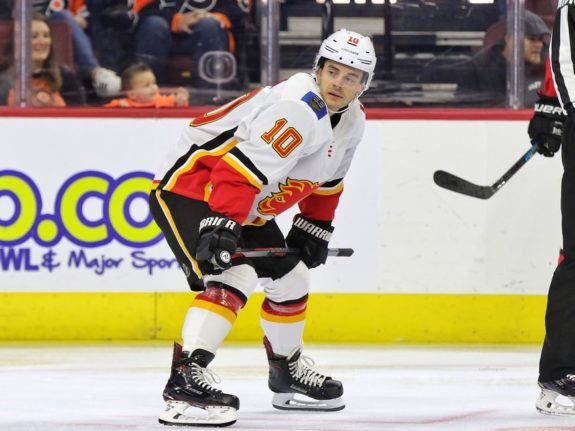The National Hockey League is a tough league to win in, with a razor-thin margin between winning and losing. That’s doubly so in the second half of the season, when games are often decided by which team makes fewer mistakes.

More than ever, it’s beneficial for a team to be able to roll four strong lines. A lack of depth was the Calgary Flames’ big weakness in previous seasons, but it’s become a strength for the club in 2018-19.
Missing Depth Kills Momentum
The 2017-18 edition of the Flames were a top-heavy group. They had two forward likes that could really cook – the top line with Johnny Gaudreau, Sean Monahan and Micheal Ferland, and a second group of Matthew Tkachuk, Mikael Backlund and Michael Frolik – but their lineup dropped off after that.
The Flames’ bottom six group involved a mixture of Jaromir Jagr, Mark Jankowski, Garnet Hathaway and Sam Bennett on the third line, with a fourth line involving a mix of Kris Versteeg, Curtis Lazar, Matt Stajan and Troy Brouwer. There were talented players involved, but not necessarily slotted properly.
The top-heavy nature of the team made it susceptible to line-matching on the road, but also made game management difficult from a coaching perspective. The bottom two lines often gave up momentum during games, requiring the other two lines to generate it from scratch on their shifts. As a result, the Flames really leaned on their top two lines and it made it difficult to have a strong forward rotation.
A Busy Summer of Upgrading
After noting after former head coach Glen Gulutzan’s dismissal that his club had relied on “too few players to do too much,” Flames general manager Brad Treliving went to work during the 2018 off-season. The Flames acquired Elias Lindholm in a trade with the Carolina Hurricanes, while adding James Neal, Derek Ryan and Austin Czarnik in free agency. They also left a lineup spot open for a potential young player to jump into the mix.
The additions resulted in a very different forward group in 2018-19: Lindholm replaced Ferland on the first line. Adding Neal to the mix dropped Hathaway to the fourth line, which displaced the bought-out Troy Brouwer. Adding Ryan functionally replaced the departing free agent Stajan. Adding a mixture of Czarnik and rotating prospects (Mangiapane and Dillon Dube) displaced free agent Versteeg and Lazar, who was sent to the AHL to find his offensive swagger.
Treliving’s tweaks gave the new coaching staff a younger, faster group with more options, but chemistry had to develop organically.
A Successful Chemistry Experiment
The Flames have been a stronger team this season than last, and a lot of the credit has to go to the role players. While a lot has been written about the excellence of their all-rookie third defensive pairing, their fourth line has done strong work in the second half of the season and given the coaching staff enough confidence to roll their lines. A group comprised of rookie Mangiapane, veteran Ryan and the rugged Hathaway has become a consistent difference-maker in limited use.
“It’s been outstanding,” said Flames head coach Bill Peters after a recent practice. “The depth that we’ve talked about, obviously they’ve made lots of plays, [Ryan’s] line, they’re real good. But where they’re real good is with structure. They’re doing everything right in the O-zone, in the neutral zone, coming through the neutral zone with speed. They’re willing to put it in behind you to establish a forecheck. i think [Mangiapane] is getting better and better all the time, and [Hathaway] and [Ryan] have been very consistent.”
"Together, when we're on, we can be pretty effective and give our team a lift."
Andrew Mangiapane is being taught the tricks of the trade by sage veteran Derek Ryan. https://t.co/82F1gvxXK7
— Calgary Flames (@NHLFlames) February 7, 2019
One of the factors that might make Treliving hesitant to make significant roster changes before the Feb. 25 trade deadline is how well the Flames’ forwards are fitting in together. Assembling a strong roster is as much about fitting pieces together as it is about grabbing a bunch of impressive pieces; you can have the 20 best players in the world together, but if the pieces don’t fit in the correct way the team won’t be successful.
Discussing the importance of roles, fit and chemistry, forward Michael Frolik compared the current Flames roster and its depth to the successful teams he was part of while with the Chicago Blackhawks.
“If you want to be successful and you want to go far, you need all four lines,” said Frolik. “I remember when I was in Chicago, when we won, all four lines could score and defend and everybody has their role and knows what to do. I think we kind of have that this year. Our first line was hot at the start, they were producing for us, but I think now we can see that all of the lines can chip in. I think if you want to be successful, that’s what you need.”
Heading into the trade deadline, the Flames will hope to add to their depth without disrupting their chemistry as they prepare for what they hope will be a lengthy playoff run.